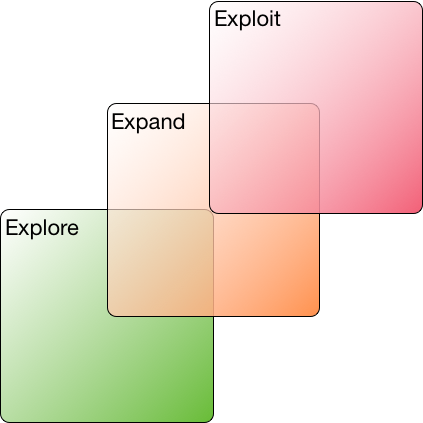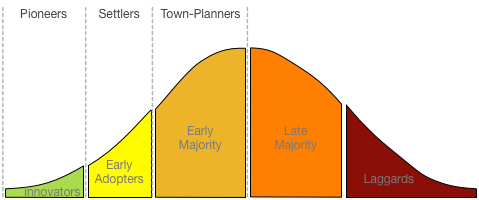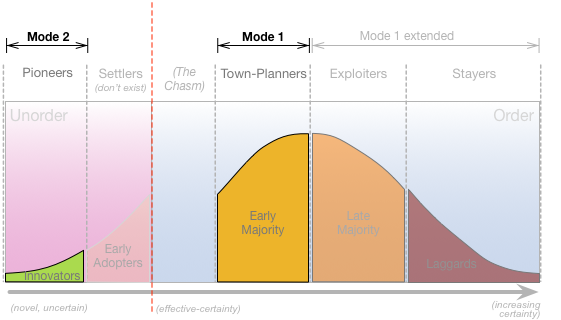Explore, expand, exploit
It seemed straightforward enough as a description of the development process: explore, then exploit.
(I forget which book we saw this in: one of Alex Osterwalder’s, I think, but I’m not sure.)
Explore, to find out what the requirements are, how to do it, run up a few prototypes, build the final deliverable – that sort of thing.
Then exploit, to make full, practical use of what we’ve developed. Maybe throw in a few tweaks and updates along the way, but the focus is on use. ‘Sweat the assets’ and suchlike.
And often, different people, different teams, running each of those stages. With a distinct handover between them, where the two stages touch.
Again, it all seemed straightforward enough, whilst I was talking it through the other day with Peter Cumper, one of my Australian enterprise-architecture colleagues.
But then it hit us: it’s exactly the same as the ‘Bimodal-IT’ mistake. ‘Explore’ as Bimodal’s agile-style ‘Mode 2’, and ‘Exploit’ as the production-oriented ‘Mode 1’.
Which, if we cross-reference it to Simon Wardley’s critique ‘Bimodal IT – the new old hotness‘, implies that there’s a whole section missing from that Explore/Exploit model – a section that would align to the ‘Settlers’ in Wardley’s three-stage ‘Pioneers, Settlers, Town-Planners’ model.
Use the term ‘Expand‘ to describe that missing step, linking between Explore and Exploit, and overlapping each in a way that links them together:
In that sense (if with some provisos), it also lines up well with the first three stages of classic Rogers technology-adoption sequence:
Rogers’ Innovators line up quite well with Wardley’s Pioneers, and the Explore mode here: they each deal with the new, or with creating the new.
Rogers’ Early Majority line up quite well with Wardley’s Town Planners, and the Exploit mode here: they each deal with making the best and most efficient use of something that already exists.
And between those two focus-areas, we have Rogers’ Early Adopters, or Wardley’s Settlers, or the Expand mode here: they each deal with making the new usable and useful.
But exactly as Simon Wardley warns about the absence of the Settlers, if the Early Adopters are missing, there’s a great big gap that can’t easily be bridged:
In which case, what would it look like if that intermediate Expand stage is missing? Conversely, what is it that happens in that Expand stage?
The short-answer is that, like Rogers’ Early Adopters, the skills in use in the Expand phase are those that take a new idea and make it work. The Explore phase produces a prototype; but that isn’t going to work well for Exploit – too unstable, too unreliable, often too inefficient, too fragile for real-world use. For one example that Peter Cumper and I discussed, Explore produces a rough-but-working prototype, which Expand reworks with cloud-services to deal with the scaling issues, privacy issues, compliance concerns and and more – giving a scalable, reliable production-ready tool that Exploit can, well, exploit.
And as shown in that diagram, there’s a cross-over here. The Expand phase starts not at the end of Explore, but about halfway through; it then guides the handover to Exploit, until the latter fully takes over at, again, around the respective halfway-point:
The key point here is that the mindsets and skillsets are different in each phase. Sure, we’ll always get some cross-over between them – again, as in that diagram above – but overall they’re not interchangeable, and we do need them all.
So, a question for enterprise-architects: In your organisation and its change-management processes, what support do you have for all three of these distinct change-domains – Explore, Expand and Exploit? And if your organisation has been afflicted by the Bimodal bug, what do you need to do, to provide the support needed to bridge that gap? – or at least to bring about the awareness that it’s a gap that needs to be bridged?
Over to you for your comments and experiences, anyway.




Good morning, Tom.
I saw this first in your post on Twitter. I immediately thought that this lines up nicely with Simon Wardley’s pioneers – settlers – town planners — but, and I should have expected this, so did you.
I’m intrigued with your notion of “making the new usable and useful”. This is beautiful. It describes a large part of what I’ve been doing professionally. It’s aspirational to me. (Even if it may not cover *all* of what I do, but no other single statement would.)
Much of the settler/expand description resonates with me. But then I’m often unsure whether ‘early adopter’ really describes me. On the one hand, I’m often impatient with the state of current technology (especially in the context of infrastructure for applications), often years ahead with my expectations of what capabilities one could ‘reasonably’ expect. Or I fail to grasp why so many companies still buy (and worse, operate and maintain) their own servers in 2020. And on the other hand, I often find myself very unimpressed with the new thing almost everyone else is excited about as I can’t just see a worthwhile benefit over current approaches. So often I feel more like an ‘very late early adopter’ or ‘very, very early majority’.
Great post, thank you very much.
O.
Many thanks for this, Oliver – I’m really, really pleased that this was useful for you.
Agreed about the not-quite-comfortable feeling about ‘Early Adopter’ – it’s one of the reasons I threw in that comment earlyish in the post about “(with some provisos)”. As Simon Wardley points out, the Early Adopter does not line up exactly with the Settler mode – not least because one (Early Adopter) is about the take-up of a technology, whereas the other (Settler, and also Expand) are about more how we make it possible for that technology-takeup to happen. They do all sort-of align – but alignment here is not the same as equivalence.
Another way to look at this: in essence, Explore, Expand, and Exploit represent different mindsets and skillsets – related, yes, but distinctly different. One of the things that we do in our own work is to switch between mindsets according to which aspect of the work we’re doing at the time – an ability to do that is pretty much a requirement in our work. For many people, though, that’s not something that they’d do as a matter of course, in fact are often very uncomfortable doing so. (Robert Pirsig gives a great example of of this, with two different kinds of welders: the production-welder, who likes doing the same thing over and over, and the maintenance-welder who hates doing the same thing twice. The point that Pirsig was making was that it’s not a good idea to mix them up… 😮 )
It’s bringing me joy to see you posting again Tom!
And I do very much agree with the discussion above. I would like to explore where there may be performance data around these transitions, both for evidence and to shed further light on how the dynamics of the expand phase may unfold in various contexts.
As always, best regards – and I look forward to catching up soon!
Nate